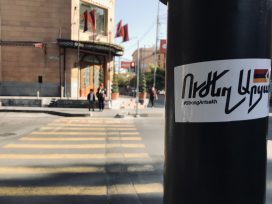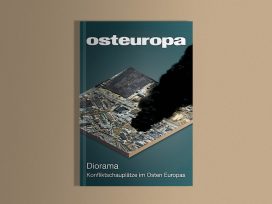"The vodka was supposed to cleanse our thyroid glands"
Igor Kostin on his Chernobyl photos
Igor Kostin took the first photo of the exploded reactor in Chernobyl and later joined the “liquidators” clearing away contaminated debris. Later he documented the evacuation of people from the thirty kilometre zone, and over the next seventeen years photographed the visible and invisible consequences of the contamination. Here he talks about his life work.
Christine Daum: Mr Kostin, you took the first photo of the catastrophe in Chernobyl. How did that come about?
Igor Kostin: A friend of mine, a helicopter pilot, called me in the middle of the night and said: come quick, something’s going on in Chernobyl! Something’s happened there! It takes about forty-five minutes to fly from Kiev to Chernobyl. The helicopter made a terrible din, so we’d put on ear protectors and didn’t talk on the way. On our approach to Chernobyl, I suddenly saw the extent of the catastrophe, the burning, open reactor: an eerie, magical scene. And it was completely silent – I couldn’t hear a thing because of the ear protectors.
I grabbed my camera immediately. I didn’t know what I was doing. I just opened the doors of the helicopter and began taking photos. At this moment we were perhaps around fifty metres over the open reactor. I took a camera, one with a motor, pressed the automatic trigger and got off around twenty or thirty pictures. Suddenly the camera gave up. I took another. That also stopped working after five shots. One camera after the other broke down. Sorry, I said, something’s wrong with the cameras. I can’t work. We circled the reactor once and then flew back to Kiev.
On the way back all of a sudden my throat tightened. I felt queasy. I began to cough and had to throw up. It hadn’t got anything to do with flying in the helicopter, I’d never had a problem with that. Then when I’d developed the films in the lab I saw that that only the first six or seven exposures were on the film. The rest was black. That came from the radiation. It had destroyed the motors of the cameras and the film. By the end all the cameras had broken down.
CD: The sole photo that remained of the few taken on the day of the explosion you gave to your agent. But the Soviet news agency TASS didn’t even publish it. How was that for you? You risked your life taking this picture – and then it wasn’t published!
IK: In fact it was a little different. I was working for the Novosti news agency, the biggest agency in those days. However, I had only received a permit to photograph in Chernobyl from 5 May. The fact that I’d been to Chernobyl before that was illegal and forbidden. The first photos that I took were of course not published, neither were they made available to foreign agencies. Of course, that annoyed me beyond measure, but what was I to do?
At the time the regime tried through every means possible to hide the truth about Chernobyl, about the accident itself, about the extent of the tragedy, and about the number of people harmed by the accident. It was all covered up and for that reason it’s hard to comment on it even today.
© Corbis/Verlag Antje Kunstmann
CD: Why, in the first few days after the accident, when you already knew about the dangers, did you keep going back to the open reactor?
IK: The news about the accident spread throughout the world like wildfire. The Chernobyl catastrophe really did affect the whole of Europe: France, Germany, Norway, Switzerland – everyone was affected. But no one knew exactly what had happened, we had only a very small amount of information.
As a reporter, I understood at once that something had to be done. The whole world was talking about the catastrophe, and something had to be found out about it. What was I supposed to do – stay in Kiev, write a satire, drink coffee, and do nothing? How could I have? It was my job to go there, and I did my job. I had to go there. It was my duty to report from there.
CD: What for you is the most important picture that you took of Chernobyl in all the years?
IK: When the fourth reactor exploded, the rubble and the contaminated graphite fell on the roof of the third reactor. And this rubbish had to be cleared. The radiation was unbelievably high there. The fatal dose for a person is fifty roentgen, but there the radiation was 15 000 roentgen. That is unimaginably high. Civilization had never before experienced such a thing! First they tried to work with robots, with German ones and a Japanese. But they broke down immediately because the computers didn’t function under the radiation.
I saw how the robots bumbled around up there and couldn’t gain orientation as they were trying to clear away the rubble. One ran straight into the hole into which it was supposed to chuck the rubbish and fell in.
After that, people were sent up – ordinary soldiers worked up there. I was with them and I will respect them my whole life. For me, those photos are the most important that I took. These ordinary soldiers did the dirty work. They’re my heroes. I want with my photos to create a memorial to them, to those who no one talks about.
There was a siren up there that went off every forty seconds. Then the soldiers had to go back down. They dumped a shovel load of rubble into the reactor and came back again. They got a hundred-rouble bonus and were sent away. Those stripes that you can see at the bottom of the picture, that’s from the radiation.
© Corbis/Verlag Antje Kunstmann
And when it was all over they received a few words of thanks, the robots Petja and Wasja were given the credit, but it was human workers! I’ll honour their heroism all my life. I was with them for a long time. I went up on the roof of the reactor five times. It’s hard to talk about it. But they’re my heroes.
CD: How long were you up on the roof of the third reactor yourself?
IK: Those lads you see there – they got a certificate, an army certificate. The certificate and one hundred roubles and they were sent away. They were up on the roof just the once. I went up there five times. I’ve got five certificates.
CD: How long did you work and photograph during the Chernobyl disaster?
IK: I was effectively there for one year after the catastrophe, not for the whole time, but again and again. I’d take photos in Chernobyl and then go back to the office in Kiev for three or four days to develop them. I always felt sick when I came back to Kiev. They told us to drink vodka – the radiation was supposed to accumulate in the thyroid glands at first. And the vodka was supposed to clean them. That was prescribed to us straight up: half a glass of vodka for every two hours in Chernobyl. I don’t believe it really had any sense, but I did it every time I got back to Kiev. I drank a bottle of vodka and lots of water. After that it seemed to me the organism had been cleaned.
At the end of 1986, I was sent to hospital. I asked to be committed only when the New Year celebrations were over. But on 2 January, I went in to Clinic No. 6 in Moscow, which specializes in radiation-related illnesses. These days I’d rather not be reminded of it.
© Corbis/Verlag Antje Kunstmann
CD: Why did Chernobyl become your life work?
IK: That’s not an easy question. It really was the case that for a long time I couldn’t live without Chernobyl. After three or four days I’d have to go back. It was like a magnet. And not just for a year, but for many years.
I photographed the catastrophe and its consequences for seventeen years, in Russia, in Ukraine, and in Belarus. I went to all the regions and took photos of all aspects of the catastrophe that it’s possible to take. I was at the epicentre of the disaster. I saw down into the reactor, it was fifty metres underneath me. I saw the colours and the unbelievable light. I’d never seen anything like it before – no one in the world had seen that before.
But I also understood Chernobyl differently. What I was doing there was history, history written in the objective. For me, that was the most important reason to keep going back. I felt that history was being played out there, and that someone had to devote themselves to it seriously. My pictures are like an instruction manual for the next generation, so that something like it can never happen again.
Today, my position is that other energy sources should be considered that aren’t so dangerous. Otherwise the next disaster will happen. And that’s something we shouldn’t allow. The political leaders might be able to protect themselves, but not the ordinary people.
CD: There are experts who claim that the contaminated areas are now liveable again. What do you think?
IK: It’s criminal to claim, like the IAEA does, that you can live there again. I can get a flat for nothing in the thirty-kilometre zone where these experts can live with their families. After they’ve been there for a time they should decide whether they want to live there.
CD: You’ve photographed the biotopes that have grown there from scratch. You’ve known the contaminated zone for twenty years. How has it developed, in your judgement? Is there anything else there other than death?
IK: There’s no development and no progress. I was there four months ago, four years ago, and ten years ago. The houses are empty, the villages are ghost towns. The streets are overgrown. There will never be progress there, not in ten years, nor in twenty years, nor in a hundred years. It’s just dead.
Five years ago a girl came to me, she was eighteen at the time. She wanted to see Chernobyl at any cost. She was three-and-a-half when the disaster happened, today she’s twenty-three. We went into the flat in Pripyat where her family had lived. It was like visiting a grave. It was like a dried-up lake, everything was covered in grass and overgrown. There’s no progress there, no change, just decay.
Published 21 April 2006
Original in German
Translated by
Simon Garnett
First published by Osteuropa 4/2006 (German version)
Contributed by Osteuropa © Igor Kostin, Christine Daum/Osteuropa Eurozine
PDF/PRINTNewsletter
Subscribe to know what’s worth thinking about.



